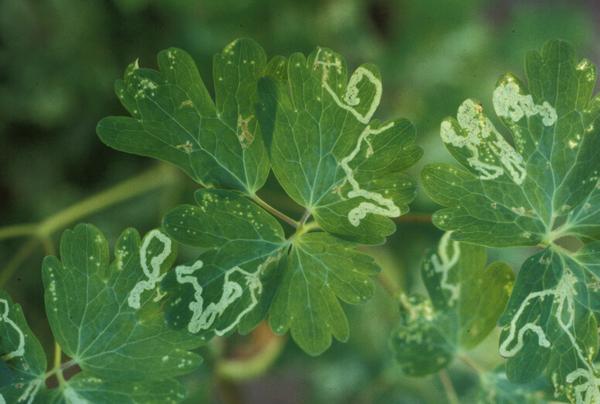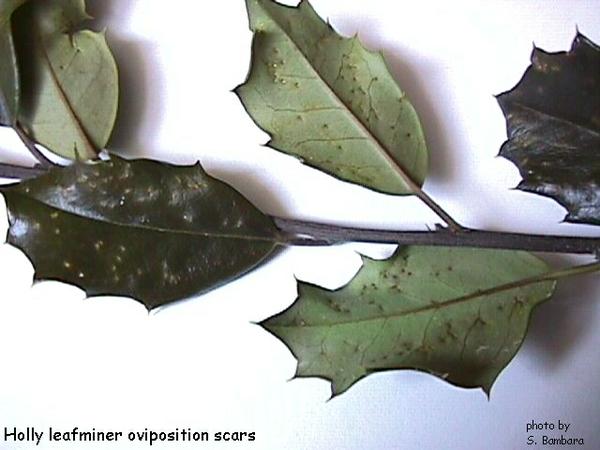General Information
Leafminers in the family Agromyzidae are small and usually dark flies. Some species have yellow markings. These flies are fairly similar and are more easily recognized by their host plant and the damage to the host plant than by the insect itself. Some leafminer maggots make serpentine tunnels that increase in size as the maggots grow. Other species make blotch mines or mines that are intermediate. This note does not pertain to the boxwood leafminer (Boxwood Leafminer), a gall-forming fly belonging to a different family.
Leafminer flies are pests of columbine, butterfly weed, chrysanthemum, cineraria, delphinium, gerbera daisy, holly, impatiens, mist flower, verbena, water lily and other ornamentals.
The larkspur leafminer causes blotch mines in the leaves of delphinium, larkspur and aconite. Females lay eggs in the leaf and the maggots make mines as they feed between the upper and lower leaf surface. Mature maggots crawl from the mine to pupate on a leaf nearby. There are several generations per year. Infested leaves look as though they have been blighted by a disease. Heavy infestation can cause significant damage to plant appearance though on large trees they are less noticeable.
The holly leafminers make typical serpentine mines in the leaves of hollies. They may also leave tiny pin hole scars from egg-laying. The maggots pupate at the large end of the tunnel and the adult fly emerges from a hole in the pupal skin and the upper leaf surface. Each species of holly has its own leafminer species. Deciduous holly leafminers have several generations per year, whereas the leafminers of evergreen hollies have only one generation per year. Leafminer maggots have parasites that often decimate the leafminer population.
Control
Because leafminers are plagued by parasites, it may be better to rely on parasites to suppress leafminers than to apply pesticides that might eliminate the parasites and force the amateur horticulturist into an ongoing spray program.
For the leafminer flies of evergreen hollies, timing of pesticide application is important for optimum suppression. If the leafminers appear to be getting out of hand, one strategy is to realize that the adults emerge in the spring to lay eggs in new leaves. In early April place several infested leaves in a dry plastic bag in the shade. When the small, dark flies are found in the bag, that is the perfect time to spray. Because leafminers are usually protected by the leaf surface on top and bottom, systemic pesticides (pesticides absorbed and translocated by the plant) should be given consideration for control. The foliage of susceptible plants should be observed for early signs of an infestation. When tunnels are first noticed, pesticides can be used for control on annual and perennial flowers and hollies. Read and follow labelling directions and warnings carefully!
Other Resources
- Common Columbine Pests: Columbine Leafminer and Columbine Sawfly. Mahr, S. 2016. Master Gardener Program, University of Wisconsin-Extension
- Holly Leafminer (Phytomyza ilicicola). Shimat, V. J. No Date. Landscape Pest Management, UGA Extension.
- Insect and Related Pests of Flowers and Foliage Plants. Baker, J. R. ed. 1994 (revised). NC Cooperative Extension Service publication AG-136.
- Insect and Related Pests of Shrubs. Baker, J. R. ed. 1980. NC Agricultural Extension Service publication AG-189.
- Larkspur (Delphinium), Plant Health Problems. Anonymous. 2007 (modified). Connecticut Agricultural Experiment Station.
- Extension Plant Pathology Publications and Factsheets
- Horticultural Science Publications
- North Carolina Agricultural Chemicals Manual
For assistance with a specific problem, contact your local N.C. Cooperative Extension Center.
Publication date: Aug. 1, 2010
Revised: Oct. 1, 2019
Recommendations for the use of agricultural chemicals are included in this publication as a convenience to the reader. The use of brand names and any mention or listing of commercial products or services in this publication does not imply endorsement by NC State University or N.C. A&T State University nor discrimination against similar products or services not mentioned. Individuals who use agricultural chemicals are responsible for ensuring that the intended use complies with current regulations and conforms to the product label. Be sure to obtain current information about usage regulations and examine a current product label before applying any chemical. For assistance, contact your local N.C. Cooperative Extension county center.
N.C. Cooperative Extension prohibits discrimination and harassment regardless of age, color, disability, family and marital status, gender identity, national origin, political beliefs, race, religion, sex (including pregnancy), sexual orientation and veteran status.


